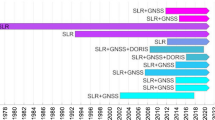Abstract
We assess the accuracy of some indirect approaches to invariant point (IVP), or system reference point, determination of satellite laser ranging (SLR) and very long baseline interferometry (VLBI) systems using both observed and simulated survey data sets. Indirect IVP determination involves the observation of targets located on these systems during specific rotational sequences and by application of geometrical models that describe the target motion during these sequences. Of concern is that most SLR and VLBI systems have limited rotational freedom thereby placing constraint on the reliability of parameter estimation, including the IVP position. We assess two current approaches to IVP analysis using survey data observed at the Yarragadee (Australia) SLR and the Medicina (Italy) VLBI sites and also simulated data of a large rotationally constrained (azimuth-elevation) VLBI system. To improve reliability we introduce and assess some new geometric conditions, including inter-axis, inter-circle and inter-target conditions, to existing IVP analysis strategies. The error component of a local tie specifically associated with the indirect determination of SLR and VLBI IVP is less than 0.5 mm. For systems with significant rotational limits we find that the inter-axis and inter-circle conditions are critical to the computation of unbiased IVP coordinates at the sub-millimetre level. When the inter-axis and inter-circle geometric conditions are not imposed, we retrieve biased vertical coordinates of the IVP (in our simulated VLBI system) in the range of 1.2–3.4 mm. Using the new geometric conditions we also find that the axis-offset estimates can be recovered at the sub- millimetre accuracy (0.5 mm).
Similar content being viewed by others
References
Altamimi Z, Sillard P, Boucher C (2002) ITRF2000: a new release of the international terrestrial reference Frame for earth science applications. J Geophys Res 107(B10):2214 DOI:10.1029/2001JB000561
Bergstrand S, Haas R, Johansson J (2000) A new GPS–VLBI tie at the Onsala space observatory. In: Vandenberg N, Baver K (eds) International VLBI service for geodesy and astrometry 2000, general meeting proceedings of NASA/CP-2000-209893, Kotzting, pp 128–132
Combrinck L (2000) Local surveys of VLBI telescopes. In: Vandenberg N, Baver K (eds) International VLBI service for geodesy and astrometry, general meeting Proceedings of NASA/CP-2000-209893, Kotzting, pp 118–127
Combrinck L, Merry CL (1997) Very long baseline interferometry antenna axis offset and intersection determination using GPS. J Geophys Res 102(B11):24741–24743
Harvey B (1991) Telescope axes surveys. Aust J Geod Photogram Surv 54:1–18
Haas R, Kirchner M (2001) Local survey activities at the Onsala Space Observatory 1999–2001. Proceedings of the XV working meeting on European VLBI for geodesy and astrometry, Institut d’Estudis Espacials de Catalunya, Consejo Superior de Investigaciones Científicas, Barcelona, pp 177–184
IERS (2005) In: Richter B, Dick WR, Schwegmann W (eds) Proceedings of the IERS workshop on site co-location. IERS technical note no. 33, international Earth rotation and reference systems service, Central Bureau, Verlag des Bundesamts für Kartographie und Geodäsie, 148 pp
Johnston G, Dawson J (2004a) The 2003 Yarragadee (Moblas 5) local tie survey. Geoscience Australia record 2004/19, 27 pp http://www.ga.gov.au/geodesy/reports/localties/
Johnston G, Dawson J (2004b) The 2002 Mount Pleasant (Hobart) radio telescope local tie survey. Geoscience Australia record, 2004/21, 21 pp. http://www.ga.gov.au/geodesy/reports/localties/
Johnston G, Dawson J, Naebkhil S (2004) The 2003 Mount Stromlo local tie survey. Geoscience Australia record, 2004/20, 26 pp. http://www.ga.gov.au/geodesy/reports/localties/
Ma C (1978) Very long baseline interferometry applied to polar motion, relativity and geodesy. Technical memo 79582, NASA, Greenbelt
Matsuzaka S, Hatanaka Y, Nemoto K, Fukuzaki Y, Kobayashi K, Abe K, Akiyama T (2002) VLBI–GPS Collocation method at Geographical Survey Institute. In: Vandenberg N, Baver K (eds) International VLBI service for geodesy and astrometry 2002, general meeting Proceedings of the NASA/CP-2002-210002, Tsukuba, pp 96–100
Microsearch (1993), GeoLab user’s guide—version 93-05-20. http://www.msearchcorp.com
Ray J, Altamimi Z (2005) Evaluation of co-location ties relating the VLBI and GPS reference frames. J Geod 79(4–5):189–195 DOI: 10.1007/s00190-005-0456-z
Sarti P, Sillard P, Vittuari L (2004) Surveying co-located space-geodetic instruments for ITRF computation. J Geod 78(3): 210–222 DOI: 10.1007/s00190-004-0387-0
Sawyer R (2001) STAR*NET-PRO V6 least squares survey network adjustment program reference manual, Oakland
Strang van Hees GL (1982) Variance-covariance transformations of geodetic networks. Manuscr Geod 7(1):1–20
Author information
Authors and Affiliations
Corresponding author
Rights and permissions
About this article
Cite this article
Dawson, J., Sarti, P., Johnston, G.M. et al. Indirect approach to invariant point determination for SLR and VLBI systems: an assessment. J Geod 81, 433–441 (2007). https://doi.org/10.1007/s00190-006-0125-x
Received:
Accepted:
Published:
Issue Date:
DOI: https://doi.org/10.1007/s00190-006-0125-x




